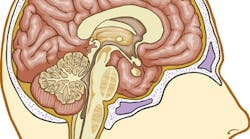Have you ever known a patient, or a friend or colleague, to burst out laughing or crying at what seems an inappropriate time? I have—in the case of a patient with amyotrophic lateral sclerosis (ALS), also known as Lou Gehrig’s disease. This article will review pseudobulbar affect (PBA), and the emotional outbursts that can occur when one has Alzheimer's disease (AD), Parkinson's disease (PD), or other neurological disorders.
What is PBA?
PBA, a disorder traced to neurologic damage, manifests as sudden, emotional outbursts that are not connected to an internal emotion.1 It is seen in many neurologic conditions, including ALS, PD, multiple sclerosis (MS), AD, and other dementias. It can also be connected to a stroke, traumatic brain injuries (TBI), nervous system tumors, neurogenetic syndromes, viral cerebellitis, neurosyphilis, and progressive supranuclear palsy.2 Other names for this condition are pathologic crying or laughing, emotional incontinence, emotional lability, emotional instability, compulsive laughing or crying, and organic mood disorder.1
READ MORE | Living with Parkinson’s and looking for relief
A number of years ago, I had a patient who was diagnosed with ALS. He was cognizant enough to explain to me his diagnosis, the symptoms, and the prognosis. A few times during the procedure he would begin laughing maniacally, and was able to explain to me that it was an uncontrollable response and part the ALS mix of symptoms.
"Mood" vs. "affect"
Do you know the difference between “mood” and “affect”? We all know what mood is. “Affect” is sometimes referred to as the behavioral manifestation of mood. Others use this analogy: Mood is the season and affect is the weather.3 PBA represents an affect that does not correctly reflect mood.
The pathophysiology of PBA is presently unknown. The most significant theory theorizes that emotional outbursts are being independently generated in the brainstem due to loss of regulatory control by the frontal lobes.4 In lay language, we may consider it as a short circuit in the part of the brain that controls emotion. (For a good anatomical representation of this, visit the Nuedexta site here.)
The outbursts can be sudden. They are involuntary and uncontrollable. They can last for seconds or minutes.5 If a patient has an established neurological problem, these outbursts can be considered symptoms of that condition. If the patient has not been diagnosed, he or she should be referred to a physician for a differential diagnosis. Stroke, Lyme disease, brain tumors, ALS, dementia, head trauma, and other diseases and conditions should be considered as possible causes of PBA. PBS is sometimes misdiagnosed as depression, and is sometimes experienced concurrently with post-traumatic stress disorder (PTSD).6
READ MORE | Fleeting memories: Staying interactive with patients suffering from dementia
According to Batya Swift Yasgur, MA, LMSW, dextromethorphan hydrobromide/quinidine sulfate (DM/Q, brand name Nuedexta) is the only FDA drug approved specifically for PBA.6
How do we apply this to our practice? We now have a better understanding of this behavior should it be exhibited by a patient with a known neurological disease, disorder, or injury. We can also feel confident referring a patient for a neurological consult with a psychiatrist, psychotherapist, or other health-care provider.
For more information on PBA, resources, patient stories and more, visit the Nuedexta website.7 PBA is no laughing matter, and may be a cry for help.
Editor's note: This article was originally published in 2015 and has been updated as of June 2025
References
1. King RR and Reiss JP. “The epidemiology and pathophysiology of pseudobulbar affect and its association with neurodegeneration.” Degenerative Neurological & Neuromuscular Disease. 2013; 3(3):23-31.
2. Jain S. “Pseudobulbar affect: no laughing matter.” Current Psychiatry 2014; 13(4):66.
3. The Royal Children’s Hospital Melbourne Clinical Practice Guidelines: Mental State Examination. http://www.rch.org.au/clinicalguide/guideline_index/Mental_State_Examination/. Accessed 10 July 2015.
4. Balakrishnan P and Rosen H. “The causes and treatment of pseudobulbar affect in ischemic stroke.” Curr Treat Options Cardiovasc Med. 2008 Jun;10(3):216-22.
5. Cummings JL. “Involuntary emotional expression disorder: definition, diagnosis, and measurement scales.” CNS Spectr. 2007; 12(4 Suppl 5):11-16.
6. Yasgur BS. “Uncontrollable Crying or Laughing: What's Behind Pseudobulbar Affect?” Psychiatry Advisor. http://www.psychiatryadvisor.com/neurocognitive-disorders/pseudobulbar-affect-uncontrollable-laughing-crying/article/424362/. Accessed 3 July 2015.
7. Psuedobulbar Affect | About PSA. https://www.nuedexta.com/about-pba. Accessed 10 July 2015.
About the Author
Maria Perno Goldie, RDH, MS
Maria Perno Goldie, RDH, MS, was previously the editorial director of RDH eVillage FOCUS.
